Whether you're managing sales, lead generation, collections, or proactive support teams, effective outreach is key. But many businesses struggle with things like limited visibility and time-consuming manual processes, which can slow things down and prevent the results you want.
An outbound center equipped with the right tools and technology can turn that around. If you're looking to boost conversions, make better use of resources, or improve team performance, let’s dive into how outbound contact centers can help.
What Is an Outbound Contact Center?

An outbound contact center is a business function where teams proactively reach out to prospective or existing customers. Agents handle tasks like sales, lead generation, appointment setting, and surveys to connect and engage with customers.
These teams often use a contact center solution, a dedicated system for managing and optimizing these interactions. It includes tools like automated dialing, call monitoring, and compliance features.
You don’t have to have a large outbound contact or call center to benefit from these platforms. Any team doing outreach—whether for sales, customer follow-ups, or surveys—can use contact center solutions.
Differences Between Contact Center and Call Center
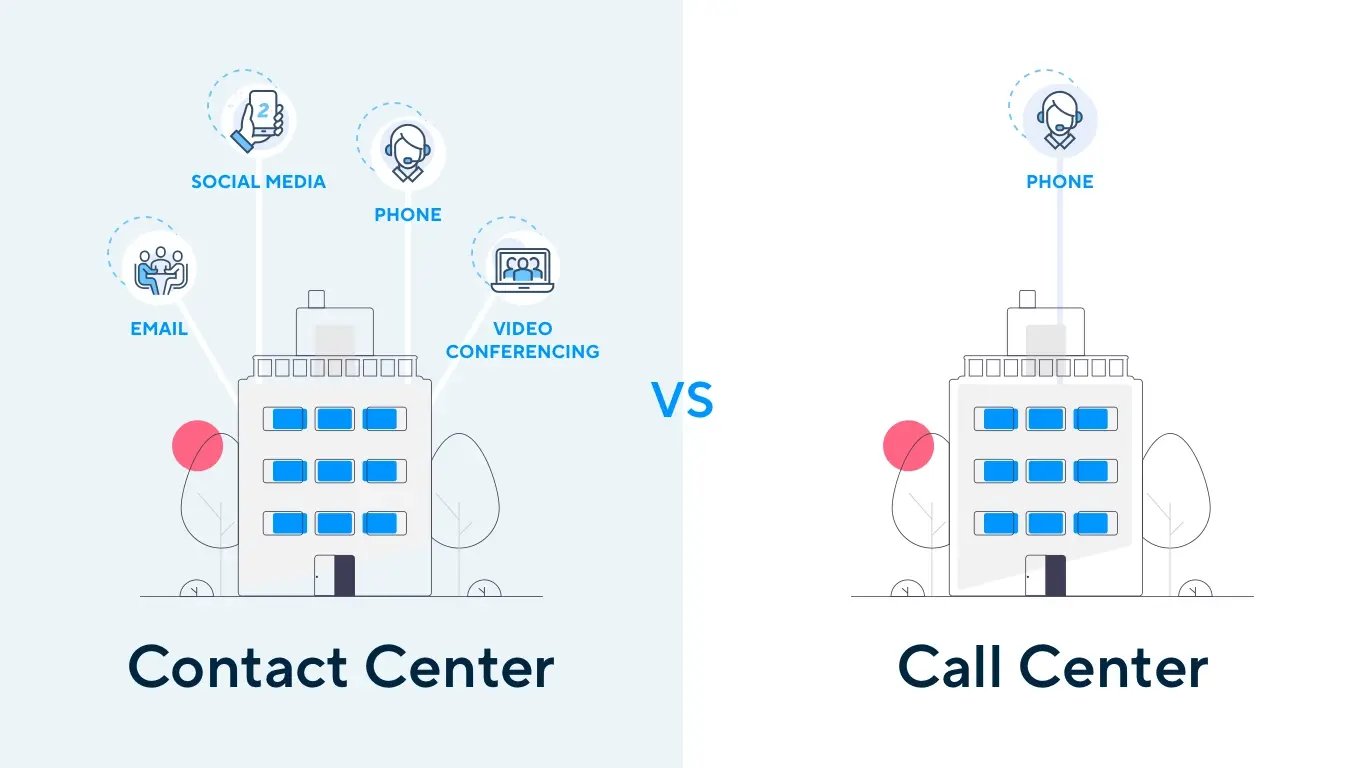
Even though both focus on reaching out to existing or prospective customers, there are notable differences between contact centers and call centers.
The key distinction lies in how they reach out.
- An outbound call center only makes outgoing phone and voice calls.
- An outbound contact center engages with customers using phone and other communication channels, such as emails, SMS, and social media.
In short, an outbound contact center is more versatile and integrates multiple outreach methods to connect with customers.
Outbound vs. Inbound Contact Center
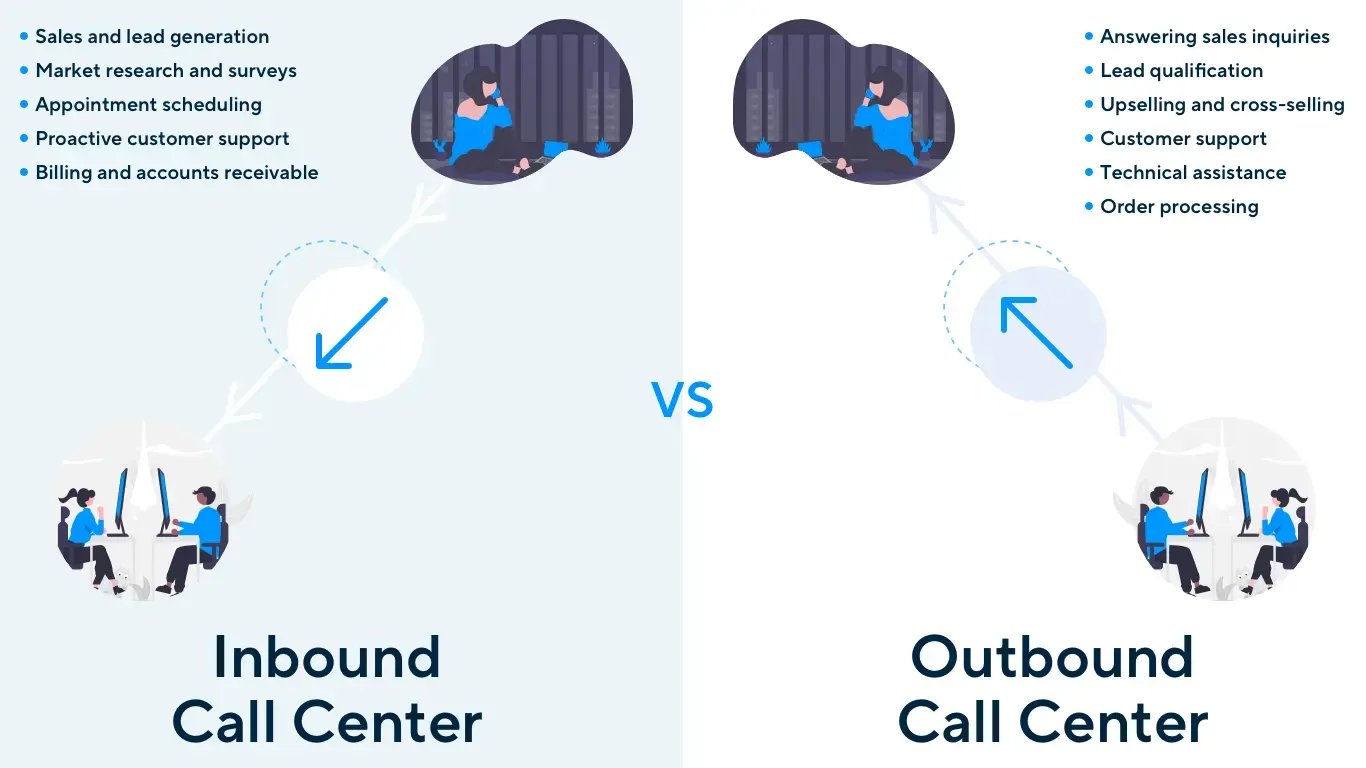
Let’s break down the two main types of contact centers: outbound and inbound.
| |
Outbound Contact Centers
|
Inbound Contact Centers
|
|
Approach
|
The team proactively reaches out to customers and prospects.
|
The team responds to customers and prospects who initiate contact.
|
|
Functions
|
- Sales and lead generation
- Market research and surveys
- Appointment scheduling
- Proactive customer support
- Billing and accounts receivable
- Follow-up and reminders
- Customer reactivation
|
- Answering sales inquiries
- Lead qualification
- Upselling and cross-selling
- Customer support
- Technical assistance
- Order processing
|
|
Technology Used
|
- Voice, video conferencing, SMS, social media, chat
- Auto-dialers
- List management tools
- Customer surveys
- Call monitoring
- Call scripting
- Integration with CRM
- Integration with sales automation tools
|
- Voice, video conferencing, SMS, social media, chat
- Interactive voice response(IVR)
- Ring groups
- Call queues
- Self-serve options
- Chatbots
- Call recording and transcription
- Integration with CRM
- Integration with ticketing software
- Integration with helpdesk platforms
|
|
Challenges
|
- High rejection rates
- Compliance and regulation
- Maintaining engagement
|
- High call volumes
- Agent productivity
- Resource allocation
|
Seven Functions For Outbound Contact Center
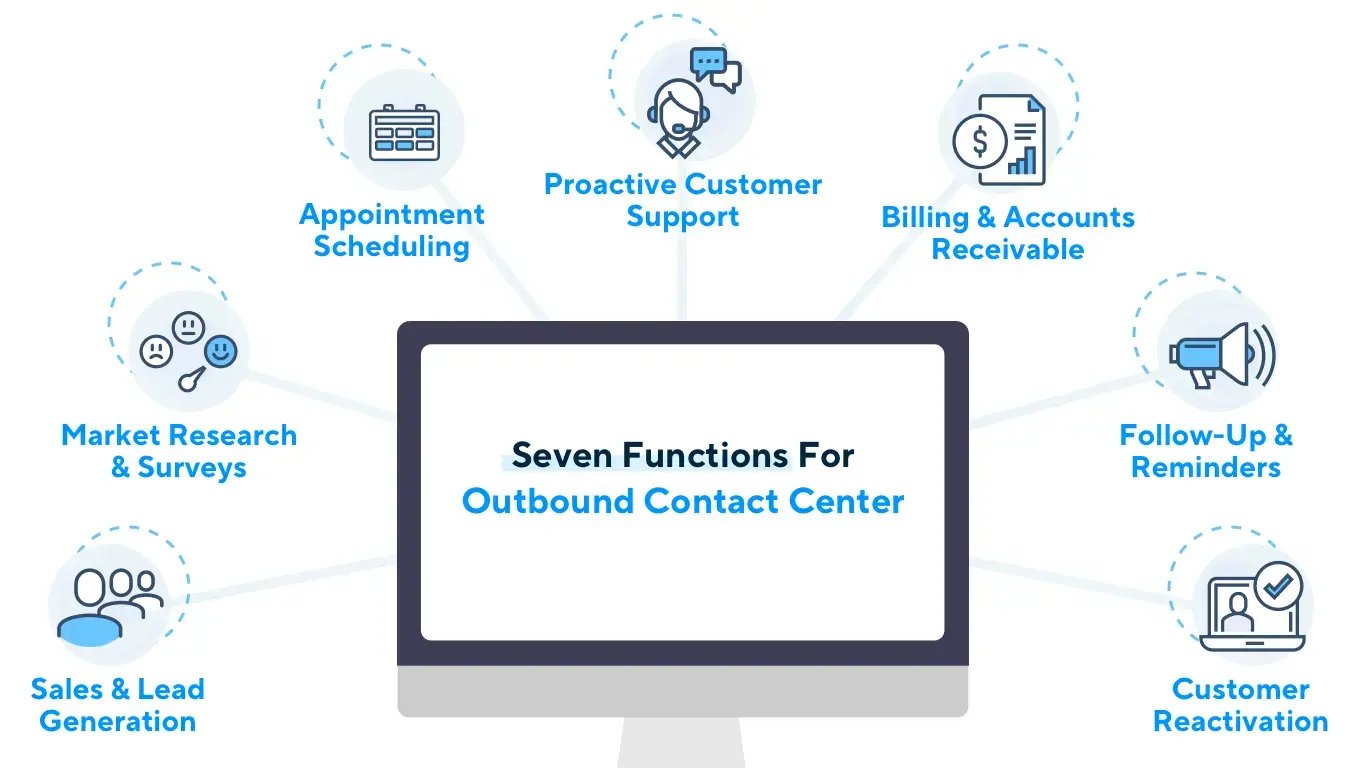
Outbound contact centers handle a range of tasks, from boosting sales to improving customer experience.
Here are seven key functions of outbound contact centers:
1. Sales and Lead Generation: Outbound teams are go-getters—reaching out to new prospects through warm or cold calls, introducing what you offer, and closing deals. They also keep your sales pipeline full of qualified leads.
2. Market Research and Surveys: Want to know what your customers really think? These centers gather valuable insights into preferences and market trends through smart, targeted surveys.
3. Appointment Scheduling: Outbound teams smoothly handle booking meetings and demos with potential clients and save you from the back and forth.
4. Proactive Customer Support: Outbound agents don’t just wait for problems to arise. They actively check in with customers, offering solutions and sharing updates.
5. Billing and Accounts Receivable: Outbound contact centers manage overdue payments, negotiate payment plans, and ensure debt recovery.
6. Follow-Up and Reminders: Outbound teams send timely follow-ups and reminders for key events like renewals and payment deadlines keeping everything on track.
7. Customer Reactivation: Outbound teams are experts at re-engagement, reaching out to former customers with targeted offers or reminders to help rekindle interest in your brand.
Examples of Outbound Call Centers

We’ve all received those calls – sometimes they catch us at the perfect moment, and sometimes not. But there’s always a purpose behind each one. Outbound call centers are designed to connect with people for specific reasons.
Here are a few examples of how outbound call centers are used in different industries and teams.
Healthcare Follow-Up Centers
Healthcare call centers contact patients after appointments or hospital stays. They ensure patients understand their care instructions, schedule follow-ups, and monitor recovery. Having the right communication system for healthcare helps improve patient outcomes and satisfaction.
Financial Services Appointment Setting
Outbound contact centers in financial services schedule consultations and follow-ups, ensuring clients stay engaged with their financial planning, investment needs, or loan inquiries, for better overall customer service.
Collections and Accounts Receivable
Accounts receivable and collections teams use outbound contact or call centers to manage overdue accounts. They remind customers of their balances, negotiate payment plans, and resolve payment issues.
B2B Technology Sales and Demos
Tech companies use outbound call centers to generate leads and schedule product demos with key decision-makers. This direct approach helps demonstrate the value of complex tech solutions and move prospects through the sales funnel.
Nonprofit Fundraising Centers
Nonprofits or charitable organizations use outbound centers to connect with potential donors and supporters, raise funds, spread awareness about causes, and recruit volunteers.
Political Campaign Centers
During elections, outbound call centers are crucial for voter outreach. They help with voter registration, fundraising, and encouraging turnout.
Utilities Customer Outreach
Utility companies often use contact centers to inform customers about new services and products, updates, and perform surveys, helping to increase customer satisfaction and loyalty through proactive communication.
Benefits of Outbound Contact Center for Business
Here are some of the benefits of outbound contact centers for businesses:
-
Boosted Sales: By simplifying outreach and focusing on high-potential leads, contact centers help sales teams close more deals faster.
-
Effective Lead Generation: With data-driven insights and automation, contact centers quickly identify and qualify leads, ensuring teams focus on prospects likely to convert.
-
Enhanced Customer Engagement: Personalized follow-ups and automated reminders help maintain consistent communication and build stronger customer relationships.
-
Cost Efficiency: Contact centers reduce the need for travel and in-person meetings, cutting costs and allowing teams to reach more customers efficiently.
-
Valuable Market Insights: Every interaction helps gather data on customer needs and market trends, giving businesses a clearer picture of their audience.
-
Increased Brand Awareness: Targeted campaigns through contact centers ensure your brand stays visible and top-of-mind for customers.
Ways to Measure Outbound Contact Center Effectiveness (KPIs)

To truly understand how well your outbound call center is performing, you have to look beyond just the number of calls made or sales closed.
A contact center solution that offers reporting and analytics tools will help you measure the performance and success of your contact center operations.
The following table includes key KPIs and their calculations to evaluate your outbound contact center's performance:
KPI
|
Description
|
How to Calculate
|
|
Call Volume
|
How many calls are coming in. This helps you plan how many people you’ll need to handle them.
|
Total number of calls handled within a specific period.
|
|
Conversion Rate
|
Shows how good you are at turning interested people into actual customers.
|
(Number of Successful Conversions / Total Number of Calls or Leads) × 100
|
|
Call Quality
|
Shows if calls meet the right standards and keep customers happy.
|
Using scores from supervisors or feedback from customer surveys.
|
|
Average Handling Time (AHT)
|
Tracks how long it takes to handle a call or interaction.
|
(Total Handling Time of All Calls) / (Total Number of Calls)
|
|
Hit Rate
|
Shows how well you’re hitting your targets and getting in touch with people.
|
(Number of Successful Outcomes / Total Number of Attempts) × 100
|
|
Agent Utilization Rate
|
Measures how well agents are spending their time reaching out to prospects.
|
(Total Talk Time + Total After-Call Work Time) / (Total Available Time) × 100
|
|
Contact Rate
|
Shows how successful you are at getting in touch with people, as opposed to getting voicemail boxes or no answers
|
Number of Contacts Made / Total Number of Attempts) × 100
|
|
Customer Satisfaction (CSAT) Score
|
Direct feedback from customers about their experience with the call.
|
(Sum of Customer Satisfaction Scores / Number of Respondents) × 100
|
|
Sales per Agent
|
How many sales or deals each agent makes, usually tied to their commission.
|
Total Sales / Number of Agents
|
|
Lead Penetration Rate
|
The percentage of leads you’ve successfully reached out to over a set time period.
|
(Number of Leads Generated / Total Number of Targeted Leads) × 100
|
Related: How To Measure Customer Experience: Tracking Key Metrics
Best Practices for Outbound Calling
By combining these best practices with the right contact center software, you can significantly enhance your outbound calling efforts,
1. Personalize Every Conversation
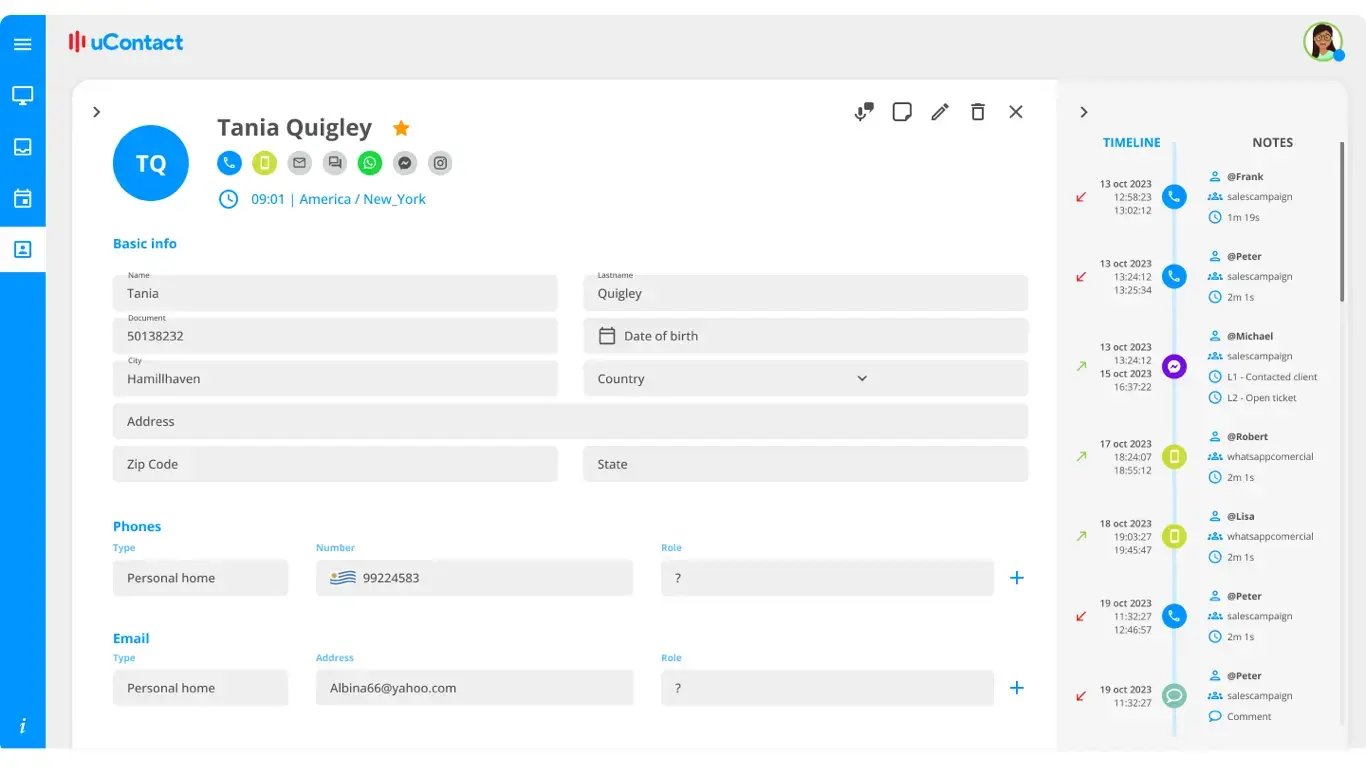 net2phone’s contact center solution uContact can integrate with your CRM and give you a view of the contact including their details and past history.
net2phone’s contact center solution uContact can integrate with your CRM and give you a view of the contact including their details and past history.
Why It Matters: Customers and prospects today expect to receive personalized service. It’s not surprising that McKinsey found that fast-growing companies generate 40% more revenue from personalization than slower-growing ones!
How Technology Helps: Having a CRM integration with your contact center solution (or using a built-in one) provides agents with instant access to detailed customer information, including past interactions, purchase history, preferences, and notes. This helps agents personalize conversations, anticipate needs, and build stronger relationships from the very beginning.
2. Optimize Outbound Calling
 uContact allows you to view analytics related to each of your dialers.
uContact allows you to view analytics related to each of your dialers.
Why It Matters: A study by Forbes found sales reps spend 64.8% of their time on non-revenue-generating activities, with only 35.2% spent on selling activities. Automating outbound calling helps ensure that agents spend more time talking to prospects.
How Technology Helps: By using predictive dialers, agents are automatically connected only to those calls that are answered. Auto dialers automate dialing, letting agents focus on engaging with customers rather than manual tasks. Both dialers boost efficiency and increase contact rates.
3. Use a Good Script
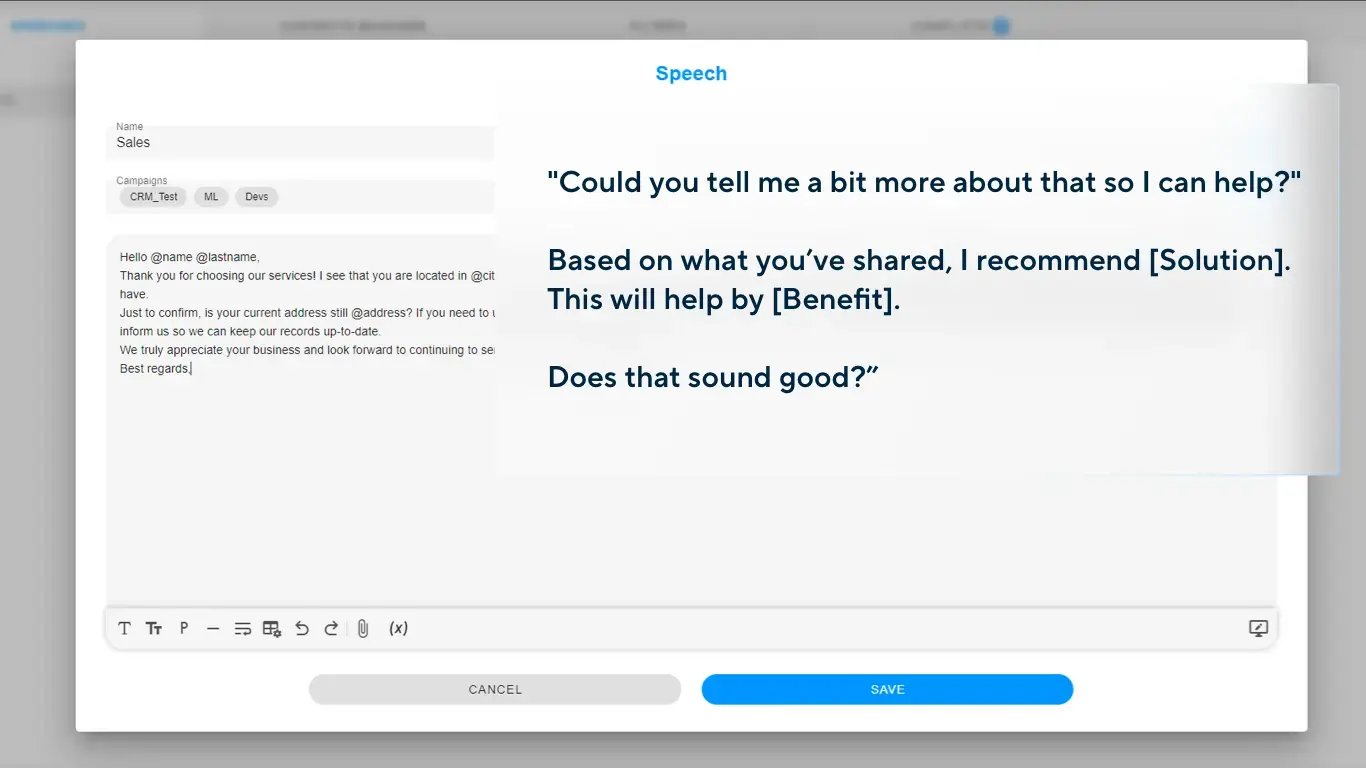
net2phone’s uContact allows you to enter scripts to help guide the conversation.
Why It Matters: When scripts are well-crafted, agents are better prepared to ask the right questions. For sales teams, this can result in improved lead qualification rates.
How Technology Helps: Your contact center solution should support call scripting so agents can respond naturally to objections, handle different scenarios smoothly, and keep the conversation flowing in a way that feels genuine and engaging.
4. Make Continuous Improvements
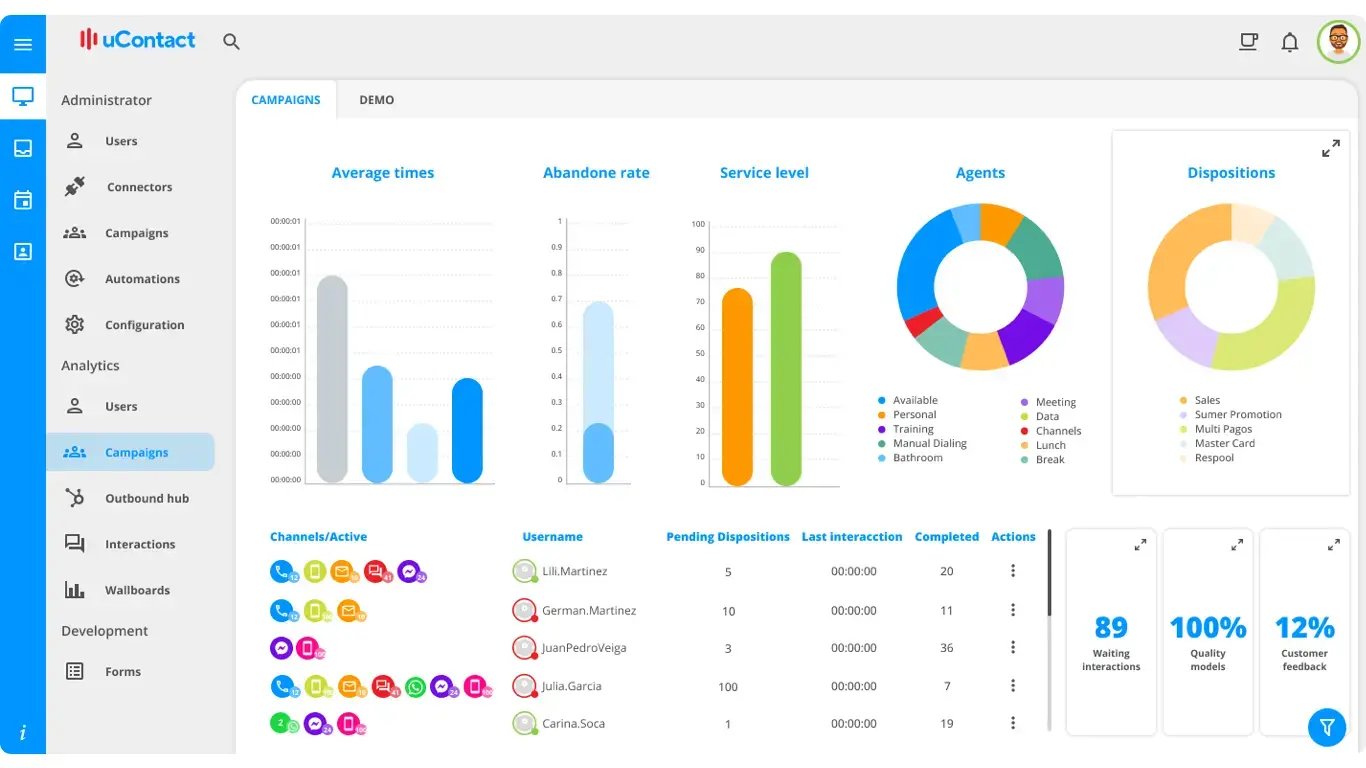 netphone’s uContact offers analytics on all your campaigns and channels.
netphone’s uContact offers analytics on all your campaigns and channels.
Why It Matters: You want to know what’s working and what’s not, so that you can adjust your outbound strategy for better results.
How Technology Helps: Get insights into call performance, such as conversion rates, call durations, and engagement patterns, with advanced analytics found in your contact center solution. This data helps you identify trends and make informed decisions for improvement. Real-time dashboards give you an up-to-the-minute overview of your team’s performance, allowing you to make adjustments on the spot to keep everything running smoothly.
5. Ensure Quality and Compliance
 uContact records and transcribes calls. You can skip over blank spaces, or skip to negative parts of the conversation for easier call reviews.
uContact records and transcribes calls. You can skip over blank spaces, or skip to negative parts of the conversation for easier call reviews.
Why It Matters: Quality assurance and compliance aren’t just buzzwords—they’re crucial for mainaining high standards and meeting regulations.
How Technology Helps: Ensure call quality and compliance with call recording and real-time monitoring. Managers can review calls, give instant feedback, and ensure adherence to best practices. Recordings also serve as valuable training tools for skill improvement.
6. Automate Tasks
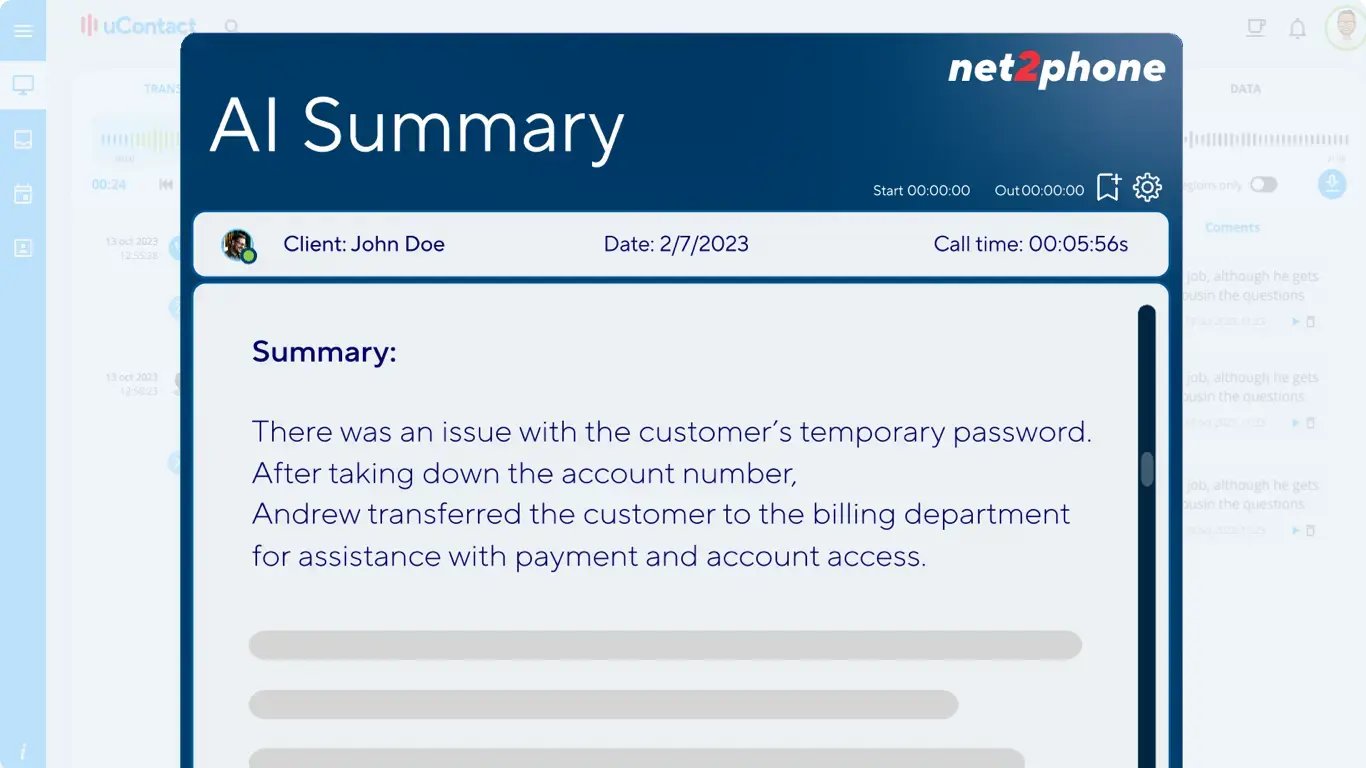
Why it Matters: Automation streamlines processes and reduces manual work. Repetitive tasks can also be automated to increase productivity and reduce costs. Accordingly, Deloitte found that 81% of contact center executives are investing in AI to enable agent productivity.
How Technology Helps: Artificial Intelligence (AI) can improve customer experience and increase agent productivity by using sentiment analysis to tailor scripts based on customer reactions, and even automate tasks like creating call summaries and follow-up emails. Machine learning helps refine these processes over time, continuously improving the effectiveness of your outbound strategies while maximizing agent output.
The Future of Outbound Contact Centers
The future of outbound contact centers is all about smarter, more personalized outreach. With advancements in AI, machine learning, and automation, these centers will become even more efficient at predicting customer needs and optimizing outreach strategies. This means sales and outreach teams can look forward to more meaningful conversations, stronger customer relationships, and, ultimately, better results.
As technology evolves, outbound contact centers will be at the forefront of driving proactive engagement and business growth.
To stay ahead in this dynamic landscape, check out uContact, net2phone’s cutting-edge contact center solution, and see how it can transform your outreach strategy.
Frequently Asked Questions - FAQ
What are the key features of outbound contact centers?
Here are some of the key features of outbound contact centers:
Omnichannel Communication: What exactly is an omnichannel contact center? They are contact centers that engage prospects through voice, SMS, email, social media, and video conferencing. They ensure you can reach customers and prospects through their preferred channels.
Auto Dialers: This feature automatically dials numbers for agents and only connects them when a live person answers. This cuts down on manual dialing and allows agents to have more conversations.
Campaign Management: These tools help contact centers create, automate, and manage outbound initiatives. Campaign management tools include campaign creation, audience targeting, scheduling, progress tracking, and performance measurement to optimize strategies and ensure more effective campaigns.
CRM Integration: Integrating your CRM with your contact center allows agents to see a single view of customers within their contact center interface. The contact center screen will show including customer data, interaction history, and purchase history. This means agents have the information to personalize the conversation.
Click-to-Dial Functionality: This feature allows agents to start calls with just a single click from their desktop, web browser, or CRM. It’s a quick, error-free way to dial and keep the conversation flowing.
Real-Time Monitoring: This feature allows managers to listen in on live calls, ensuring that quality and compliance standards are met while providing immediate feedback to agents.
Call Recording: Captures every conversation for review. It’s a goldmine for quality assurance, compliance checks, and training, helping agents refine their skills based on real interactions. It can also be used by other departments, for example, marketing who are conducting market research.
Do Not Call Management: This functionality, maintains and respects lists of individuals who have opted out of receiving calls, ensuring compliance with regulations and protecting your company’s reputation.
Remote Work Capabilities: Enables agents to work from anywhere with a stable internet connection. It’s essential for supporting remote and hybrid work environments.
Analytics and Reporting: Provides insights into call performance, agent productivity, and campaign success. It helps you track progress and make data-driven decisions to improve outcomes.
Real-Time Dashboards: Provides up-to-date overview of your team's performance at a glance so you can make adjustments on the spot.
Compliance Features: Solutions compliant with HIPAA, SOC2, and PCI regulations will keep your customer's data secure.
How to handle outbound calls effectively?
To handle outbound calls effectively, use a structured script, personalize each conversation based on customer data, and utilize tools like auto-dialers and CRM integration to increase efficiency and relevance in your outreach.
How does an outbound contact center improve customer experience?
An outbound contact center improves customer experience by providing proactive and personalized communication, addressing customer needs promptly, and offering support across multiple channels like phone, SMS, and email.
How do outbound contact centers increase revenue?
Outbound contact centers increase revenue by efficiently reaching a larger audience, nurturing potential leads, and using data-driven approaches to target and convert high-value customers, ultimately driving more sales and business growth.












